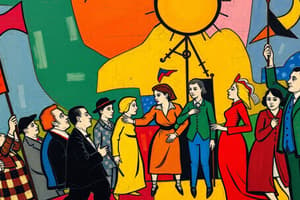Podcast
Questions and Answers
What was the Triangle Shirtwaist Fire?
What was the Triangle Shirtwaist Fire?
A devastating fire at a factory in Manhattan in 1911 that resulted in the death of 146 workers due to dangerous working conditions.
Who were the muckrakers?
Who were the muckrakers?
Journalists who exposed unsavory business practices, poverty, and corruption to challenge corporate capitalism.
What was the Club Movement?
What was the Club Movement?
A movement comprised of various female social organizations devoted to philanthropy, education, suffrage, and civil rights.
What is the Woman's Christian Temperance Union?
What is the Woman's Christian Temperance Union?
Who was Jane Addams?
Who was Jane Addams?
What are 'the trusts'?
What are 'the trusts'?
Who was John Muir?
Who was John Muir?
What was the significance of Plessy v. Ferguson (1896)?
What was the significance of Plessy v. Ferguson (1896)?
Who was Booker T. Washington?
Who was Booker T. Washington?
Who was W.E.B. Du Bois?
Who was W.E.B. Du Bois?
Flashcards are hidden until you start studying
Study Notes
Triangle Shirtwaist Fire
- Occurred in 1911 at a Manhattan factory, resulting in 146 fatalities due to unsafe working conditions.
- Highlighted the urgent need for labor and industrial reforms in the United States.
Muckrakers
- Investigative journalists focused on exposing corruption, poverty, and unethical business practices.
- Played a crucial role in challenging the dominance of corporate capitalism during the Progressive Era.
The Club Movement
- Comprised various female social organizations that aimed to promote philanthropy, education, suffrage, and civil rights.
- Enabled women to actively participate in American public life and social reform initiatives.
The Woman's Christian Temperance Union
- Female-led organization focused on combating alcoholism and promoting temperance.
- Evolved into a political force advocating for broader social reforms to enhance women's societal status.
Jane Addams
- American reformer and founder of Hull House in Chicago, pivotal in the settlement house movement.
- Advocated for urban poverty alleviation and provided avenues for self-improvement and community engagement.
"The Trusts"
- Monopolistic corporations exerting control over specific industries or products.
- Became central targets for progressive reformers aiming to regulate industry and protect workers and consumers.
John Muir
- Naturalist and writer known for his advocacy of environmental preservation over conservation.
- Emphasized the importance of protecting unspoiled natural lands for public benefit.
Plessy v. Ferguson (1896)
- Supreme Court decision legitimizing "separate but equal" doctrine, allowing racial segregation in public facilities.
- Resulted in reinforced discriminatory practices and created ambiguity regarding the enforcement of "equality."
Booker T. Washington
- Promoted industrial education and vocational training as a means to achieve economic independence for African Americans.
- Viewed as both a respected leader and a controversial "accommodationist" for his gradual approach to racial equity.
W.E.B. Du Bois
- Advocated for immediate equal rights for African Americans, opposing Washington's gradualist strategy.
- Campaigned against racial discrimination and pushed for civil rights under the law.
Studying That Suits You
Use AI to generate personalized quizzes and flashcards to suit your learning preferences.




